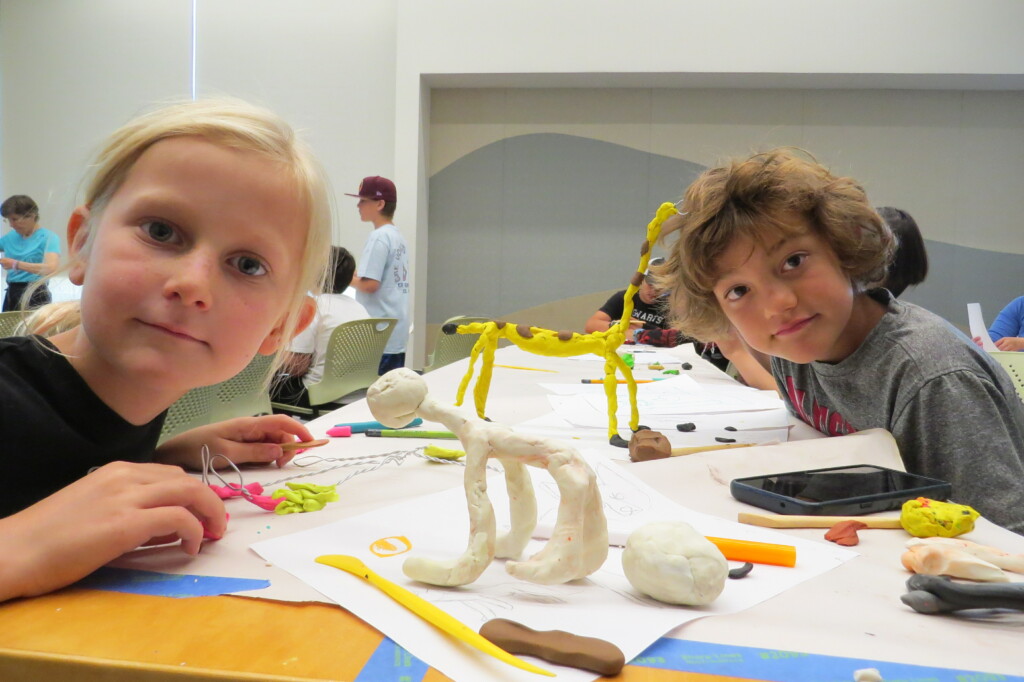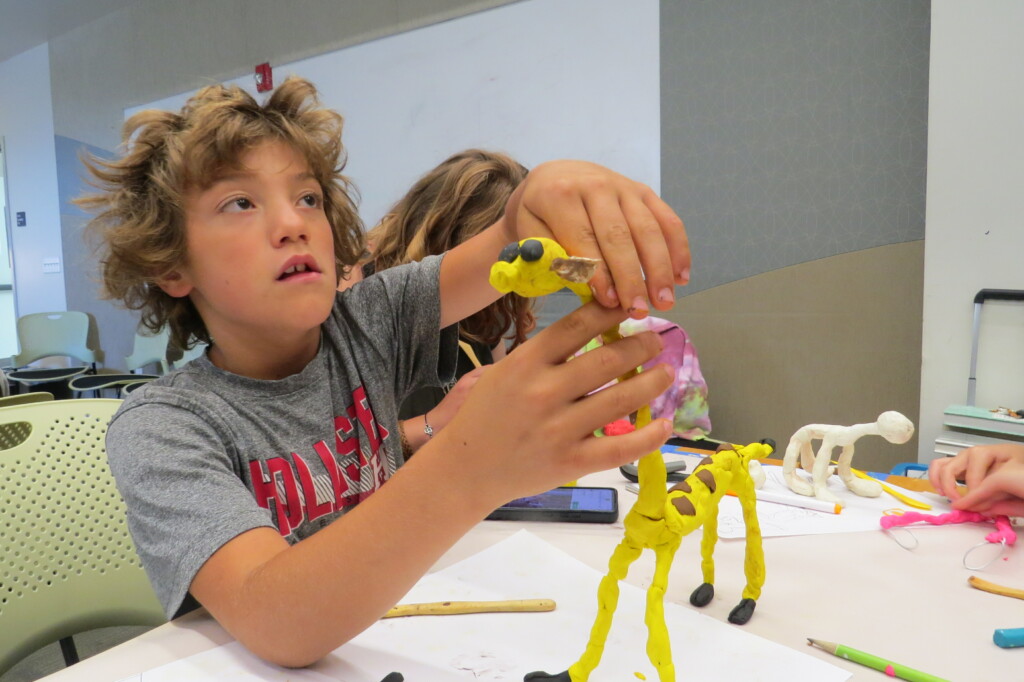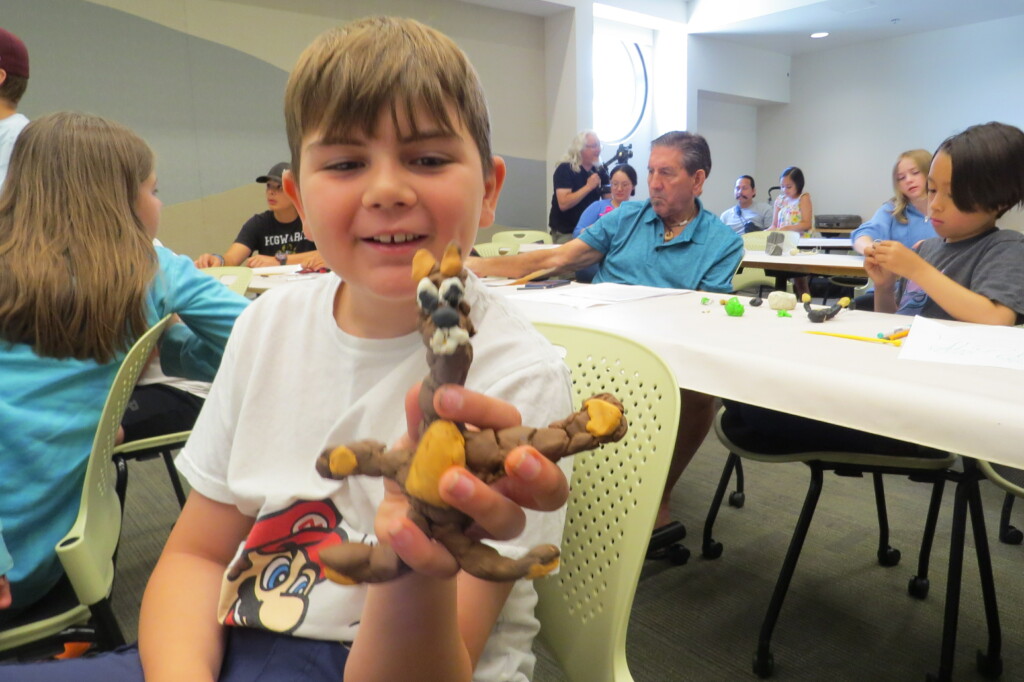Nonprofit profile: Youngsters learn how to make films from clay in PJIFF workshop
More than 30 children created cinematic art at Gilroy Library workshop put on by Poppy Jasper film festival

Photo by Marty Cheek
Avery Sims and Cameron Sims work on their claymation figures.
By Calvin Nuttall
The next generation of South Valley filmmakers recently found themselves getting a taste of the cinematic arts. Thanks to the Poppy Jasper International Film Festival’s Young Filmmakers Workshop, they learned the magic of claymation.
 More than 30 aspiring animators between the ages of four and 14 got hands-on experience in August bringing plasticine characters to life one frame at a time. During the two-day workshop at the Gilroy Library, children were introduced to the art of claymation, a classic stop-motion animation technique used in films like “Coraline” and the iconic “Gumby” cartoon series.
More than 30 aspiring animators between the ages of four and 14 got hands-on experience in August bringing plasticine characters to life one frame at a time. During the two-day workshop at the Gilroy Library, children were introduced to the art of claymation, a classic stop-motion animation technique used in films like “Coraline” and the iconic “Gumby” cartoon series.
Guided by Guillermo Gomez, the students received instruction crafting their own whimsical worlds and characters out of clay.
“It has been a great experience,” Gomez said. “This is a class I would have loved to have taken as a kid. We put this workshop together to help inspire kids to get interested in animation, claymation in particular.”
Sponsored by the Gilroy Assistance League, the two-day workshop took place at the Gilroy Library on successive Saturdays. The first day saw the participants create the stars of their miniature movies — clay figurines of people and animals molded around wire frames. Each child was free to make any kind of creature they could imagine. The breadth of creative ideas that emerged was fascinating, Gomez said.
In the second workshop, participants brought their clay creatures to life using iPads installed with an animation app called Stop Motion Studio. Either as individuals or small groups, the kids put together short films by shooting individual frames, adjusting their models slightly in between. They then combined the frames using the app.
“I think it is marvelous animation software has become more accessible and more affordable,” Gomez said. “We’re living in a great day and age where animation and camera equipment are readily available to anybody who wants to study film and animation or do it themselves.”
Using this software, Gomez was able to make the end result of each student’s film immediately viewable during the workshop by wiring his laptop to the library’s projector and AirDropping the films directly from each iPad.
 “Traditionally, it was a hard-earned privilege to be able to see your work on the big screen,” he said. “This is something that would have taken weeks to develop and cut together in the days of shooting on film. When you’re a kid and you’re able to see the results of your work directly, it leaves a very positive impression.”
“Traditionally, it was a hard-earned privilege to be able to see your work on the big screen,” he said. “This is something that would have taken weeks to develop and cut together in the days of shooting on film. When you’re a kid and you’re able to see the results of your work directly, it leaves a very positive impression.”
The young people created a wide variety of tiny stories. Because of the time-intensive nature of claymation, each film lasts only a few seconds. Will Gunter, an elementary school-aged workshop participant, decided to make a film about a worm eating an apple.
“It’s really fun,” he said. “This feels like the first day of school, but instead of having to do math we get to go off and do our own thing.”
Other films featured such action-packed scenes as giraffes eating lettuce and two people playing catch.
“By the end of the second week, after a lot of the kids had seen their work on the big screen, I told them, ‘Remember how this feels,’” Gomez said. “‘Keep this feeling with you and harness it toward your next creative endeavors.’”
The workshop was first envisioned by Mattie Scariot, the film festival’s director, in 2018. They first conducted it in 2020, and showcased the results in the 2021 festival in the form of a documentary entitled “Doing It By Hand.” Due to the downsizing of the festival during the pandemic, the workshop did not proceed in 2022, but returned this year.
 “This project holds a special place in my heart because it’s one of three educational programs I created when I first took over the festival,” Scariot said. “Over time, we have expanded to eight free programs, for youth, adults, and veterans. The primary objective of these educational programs is to foster a connection between the festival and the communities it serves. During the festival, we showcase everything that is created through our educational programs.”
“This project holds a special place in my heart because it’s one of three educational programs I created when I first took over the festival,” Scariot said. “Over time, we have expanded to eight free programs, for youth, adults, and veterans. The primary objective of these educational programs is to foster a connection between the festival and the communities it serves. During the festival, we showcase everything that is created through our educational programs.”
Gomez became involved in the project after meeting Scariot in 2019 at the Cinema Exchange, a co-working space for filmmakers in Milpitas.
“It was like kismet,” he said. “She wanted to put the class together as part of Poppy Jasper’s youth program. So I pointed out to her that I have an associate’s degree from De Anza College in animation. Soon after, we taught the first version of the class.”
This iteration of the workshop contains several improvements over the previous one, Gomez said. Thanks to his experience with the first workshop, he streamlined the process by preparing materials and demonstrations ahead of time. This allowed the workshop to be condensed to two sessions instead of the previous three.
“I pre-cut the pieces of wire so the kids wouldn’t have to measure and cut their own,” he said. “That way they could readily build their own wire figures to put clay onto. I also put together my own clay character and took pictures of each step. I showed the kids the process of how I made that, and I brought that figure to display.”
Gomez and other members of the project documented the process by taking B-roll of the kids while they were hard at work on their claymation films. This, combined with the kids’ completed films, will form a documentary to be presented during Poppy Jasper’s Youth and Student Day.
The festival runs April 10-17, 2024.
Calvin Nuttall is a Morgan Hill-based freelance reporter and columnist.

